On the Origins of New Forms of Life
1.9: Reproductive Isolation
(Continued from the previous page)
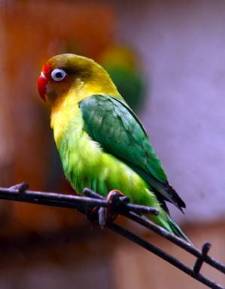 A hybrid of two lovebirds Agapornis fischeri and Agapornis personatus. Hybrids of this type are larger and more vigorous than either of their parents and are also quite fertile. A. fischeri and A. personatus hybridize extensively in Kenya and Tanzania. Image: Demosh.
A hybrid of two lovebirds Agapornis fischeri and Agapornis personatus. Hybrids of this type are larger and more vigorous than either of their parents and are also quite fertile. A. fischeri and A. personatus hybridize extensively in Kenya and Tanzania. Image: Demosh.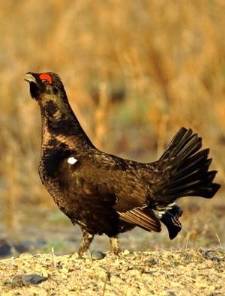 Hybrids of Black Grouse (Tetrao tetrix) and Western Capercaillie
(T. urogallus), known as rackelhahns, occur in Eurasia from
Scotland to Lake Baikal. This common hybrid has been treated as a species and is fertile in both sexes. Photo: F. C. Robiller.
Hybrids of Black Grouse (Tetrao tetrix) and Western Capercaillie
(T. urogallus), known as rackelhahns, occur in Eurasia from
Scotland to Lake Baikal. This common hybrid has been treated as a species and is fertile in both sexes. Photo: F. C. Robiller.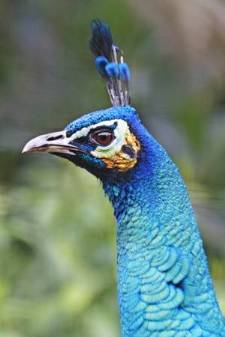 Spaulding's Peafowl,the hybrid of Common
Peafowl (Pavo cristatus) and Green Peafowl
(P. muticus), is fertile in both sexes.
Photo: Fir0002/Flagstaffoto.
Spaulding's Peafowl,the hybrid of Common
Peafowl (Pavo cristatus) and Green Peafowl
(P. muticus), is fertile in both sexes.
Photo: Fir0002/Flagstaffoto.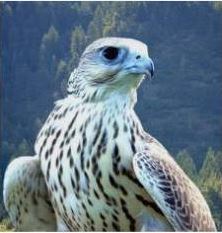 Altai Falcon: This hybrid between Gyrfalcon (Falco rusticolis) and Saker Falcon (F. cherrug) is fertile in both sexes. Many experts treat it as a species (F. altaicus).
Altai Falcon: This hybrid between Gyrfalcon (Falco rusticolis) and Saker Falcon (F. cherrug) is fertile in both sexes. Many experts treat it as a species (F. altaicus).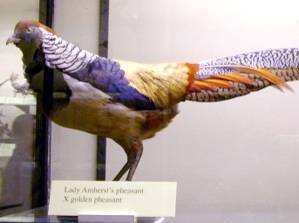 A hybrid between Lady Amherst's pheasant (Chrysolophus amherstiae) and Golden pheasant (C. pictus). These hybrids occur naturally in southern China (Yunnan and Sichuan) and are fertile in both sexes. Photo: Wikimedia.
A hybrid between Lady Amherst's pheasant (Chrysolophus amherstiae) and Golden pheasant (C. pictus). These hybrids occur naturally in southern China (Yunnan and Sichuan) and are fertile in both sexes. Photo: Wikimedia.
"Reproductive isolation" is widely considered an essential ingredient in defining the word species, but is itself vaguely and inconsistently defined.
Definitions of species in terms of reproductive isolation are called "biological." The main intellectual motive for using biological definitions has been the widespread belief that interbreeding populations will blend together (the very thing that Goldsmith and Rousseau said Dame Nature was so cautious to prevent!).
Darwin clearly thought reproductive isolation is important in maintaining distinct populations. For example, in the Origin he says "species within the same country could hardly have kept distinct had they been capable of crossing freely."¹ Elsewhere he writes "indeed it is obvious if all forms freely crossed, nature would be a chaos."² The idea that reproductive isolation is key in the production and maintenance of distinct forms is certainly emphasized in neo-Darwinian theory.
A theorist is free to imagine and model the evolutionary dynamics of a population satisfying the constraints of Mayr's definition. But for a taxonomist such a definition is an arduous criterion because it can be extremely difficult to determine whether two organisms are "actually or potentially interbreeding." The impracticality of such a criterion becomes evident as soon as one considers:
-
how many pairs of populations might, on a purely hypothetical level, interbreed (millions);
and - that each such population is typically composed of millions of individuals distributed over a broad geographic range.
How much work, then, would be required to evaluate whether even a single such pair is "actually or potentially interbreeding?" Long ago John Locke perceived the difficulties inherent in such definitions. As he put it, "If the species of animals and plants are to be distinguished only by propagation, must I go to the Indies to see the sire and dam of the one, and the plant from which the seed is gathered that produced the other, to know this be tiger or that tea?"²
Indeed, even if one fails to observe interbreeding in a given case, can one safely conclude that the organisms in question are in a state of reproductive isolation? It is always possible that hybrids may exist in some location other than those that have already been searched. Or they may occur in the same place at some other time. Surveys of natural populations are always of limited scope. As Buffon once said, regarding the possibility of natural hybridization among birds,
These difficulties have led to the practice of treating morphologically distinct forms as separate species so long as they are not known to hybridize. Once hybrids have been reported between two such forms, however, their taxonomic treatment is often changed so that they are treated as subspecies of the same species. In other words, they are no longer treated as separate species.
Many forms treated as distinct species are now known to hybridize that once were not known to do so. Indeed, in the writer's experience several such pairs are reported among birds every month. It can therefore be inferred that many such pairs that are not now known to hybridize will be found to do so in the future. Thus, forms are typically treated as species by default when their actual status with respect to reproductive isolation is unknown.
This practice contributes to the idea that organisms treated as separate species cannot hybridize — many people assume any form treated as a species doesn't hybridize with other such forms, even if no information is available about whether it does or not. Since the capacity to hybridize has not been investigated for the vast majority of those forms treated as species, this default assumption has probably greatly distorted estimated rates of hybridization between forms treated as separate species.
Obviously, if two forms can be treated as separate species only so long as hybridization between them is unknown, estimates of rates of hybridization between forms so treated will be low indeed! The fallacy of such reasoning can be made explicit with a simple example:
If it were widely supposed that an animal could not be a dog if it had fleas, then it would be hard to show that dogs often do have fleas. For suppose everyone agreed a particular animal was a dog and someone subsequently discovered that it had fleas. The discovery would be to no avail because as soon as it was announced everyone would say "That is not a dog! Dogs do not have fleas!" Since in everyone's estimation the animal would no longer be a dog, everyone would be free to go on believing dogs do not have fleas. Such would be the case even if most, or even all unexamined dogs were heavily infested with fleas.
This is just the sort of "great mistake" that Locke was talking about (see Section 1.7). Darwin was well aware of this fallacy: "There is no way to escape from the admission that the hybrids from some species of plants are fertile, except by declaring that no form shall be considered as a species, if it produces with another species fertile offspring: but this is begging the question"⁵ (italics added). Unfortunately, just this sort of waffling question begging is rampant among biologists today.
But questions of practical implementation aside, the greatest weakness of Mayr's definition is the vagueness of the word interbreeding and of the term reproductive isolation. A broad spectrum of observations could be described as "interbreeding."
There are also various conceivable degrees of reproductive isolation. Both the observation of a single hybrid and of a million can be described as "interbreeding." Also, the production of a sterile hybrid and of a fertile one can both be called "interbreeding." How fertile and how numerous must the observed hybrids be? Is one hybrid allowed? Two? Three hundred? What is the exact criterion?
Attitudes regarding hybridization, reproductive isolation, and how they should be interpreted within the context of biological classification differ from one biologist to another. Moreover, the consensus on the topic varies over time. For example, the American Ornithologists' Union's Committee on Classification and Nomenclature (AOU Check-list 1998: xiv) discusses reproductive isolation in connection with avian taxonomy:
The passage just quoted illustrates some of the sticky problems associated with defining species in terms of reproductive isolation. Interbreeding is a matter of degree and the degree that constitutes "free interbreeding" has never been objectively defined.
Precisely what does "essential" reproductive isolation mean? As used in the quotation, the word essential seems merely to indicate the Committee's opinion that in certain cases observed hybridization is not so extensive as to warrant treating the hybridizing populations as a single species. However, no exact criterion is offered by which "essentially" isolated populations can be distinguished from ones that are not "essentially" isolated.
What exactly does "free interbreeding" mean? In interbreeding that is not "free" how many hybridizations can occur? How fertile can the hybrids be? If hybridization of two forms across a "narrow and stable contact zone" is to be considered a lack of free interbreeding, then exactly how narrow and how stable must the zone be?
The writer knows from his own research that avian contact zones vary greatly, from one to another, in width and stability, as well as in degree of reproductive isolation, measured in terms of the number of hybrids they produce, and in the fertility of those hybrids.⁶
Regarding the activities of taxonomists, Ernst Mayr (1963: 499) once wrote that "an outsider would never realize how many interesting cases of evolutionary intermediacy are concealed in the seeming definiteness of the species and subspecies designations."
If it were true that natural populations could be tidily sorted into two categories, those that do interbreed and those that do not, the fact that various degrees of interbreeding are conceivable would be irrelevant. However, real pairs of populations do exhibit a seemingly continuous spectrum of degrees of interbreeding.⁷ This fact makes definitions in terms of reproductive isolation entirely arbitrary.
Although he sporadically used biological definitions of species, as the occasion suited him, Darwin was clearly aware the fertility of hybrids was an impractical criterion. He reached this conclusion by comparing the results of Kölreuter (1761-1766) and Gärtner (1849), whose works were at that time the primary sources of information on hybridization in plants. He said (see Stauffer 1975, p. 402) that
Indeed, Darwin was well aware that the fertility of hybrids is a continuum, varying from one type of cross to another. Thus, he points out that,
Moreover, even those who try to use them admit definitions based on reproductive isolation are limited in scope in comparison to morphological ones. As Grant (1981: 64) points out,
Likewise there are difficulties associated with applying it to symbiotic forms. For example, many fungi enter into associations with photosynthetic algae to form lichens. Thousands of these lichens have been treated as species, though they are composites of two or more organisms that are themselves treated as separate species. Certainly, such composite forms have nothing to do with Mayr's species.
Nor can biological concepts be applied to various other broad classes of organisms (e.g., fossil forms, bacteria). Such concepts also have nothing to say about the many natural populations that do not come into contact with each other (allopatric populations).
So for anyone who wishes to work with real specimens and natural populations, definitions in terms of reproductive isolation are not at all satisfactory.
Thus, neither of the two primary types of definitions usually offered for species (neither the morphological nor the biological) succeeds in clearly stipulating how and when the word should be applied.
Other types of definitions have been proposed in recent years. Most of the new proposals make allowance for molecular genetic data. But they have not led to consensus (Winker et al. 2007). Genetic traits are not morphological traits, but defining species in terms of the degree to which organisms differ with respect to their genetic traits is just as problematic as defining them in terms of morphological differences.
Many organisms that are known to hybridize continue to be treated as separate species simply because they have long been treated so and a tradition has been established. For example, sparrow expert T. R. Anderson (2006: 17) remarks that "despite their ability to interbreed successfully, I consider the Spanish sparrow (P. hispaniolensis) to be a separate species from the house sparrow [P. domesticus]."
Others are treated separately by some authors because they satisfy various less restrictive definitions of species.
When two hybridizing populations can be distinguished on the basis of certain characteristic, usually genetic, traits, they are good "phylogenetic species" (Cracraft 1983, 1989; Zink and McKitrick 1995) — this definition is a morphological wolf in genetic sheep's clothing (it's still a definition in terms of differences, although those differences may be genetic as well as morphological).
When they tend more to mate with their own kind than to hybridize, they are good "recognition species" (Paterson 1985). This definition faces the old problem of deciding how much hybridization is allowed.
Furthermore, when pre- and postmating isolating mechanisms reduce the reproductive capacity of hybrids and mixed parental pairs, hybridizing populations can even be good "biological species" according to Ehrlich and Raven's (1969) definition, which is like Mayr's but allows reproductive isolation to be a matter of degree (again the exact degree is not specified and is consequently arbitrary).
Problems arise with the application of all definitions that have been proposed (Winker et al. 2007). NEXT PAGE >>
1. Darwin (1859: 245).
2. Darwin (1909: 11).
3. An Essay Concerning Human Understanding, Book III, Ch. 6, 23.
4. Buffon (1749–1804: vol. XVI, xii). Translated by E. M. McCarthy. Original French: "Et qui sait tout ce qui se passe en amour au fond des bois? qui peut nombrer les jouissances illégitimes entre gens d’espèces différentes?"
5. Darwin (1909: 98).
6. McCarthy (2006).
7. Even Mendel (1866: 5) was aware of this difficulty. See (Mayr 1982: 712).
8. In Stauffer (1987: 402). Online text. Elsewhere he says it can "be shown that neither sterility nor fertility affords any clear distinction between species and varieties; but that the evidence from this source graduates away, and is doubtful in the same degree as is the evidence derived from other constitutional and structural differences" (Darwin 1859: 248).
9. Darwin (1872, vol. I, 222).
Most shared on Macroevolution.net:
Human Origins: Are we hybrids?
On the Origins of New Forms of Life
Mammalian Hybrids
Cat-rabbit Hybrids: Fact or fiction?
Famous Biologists
Dog-cow Hybrids
Georges Cuvier: A Biography
Prothero: A Rebuttal
Branches of Biology
Dog-fox Hybrids